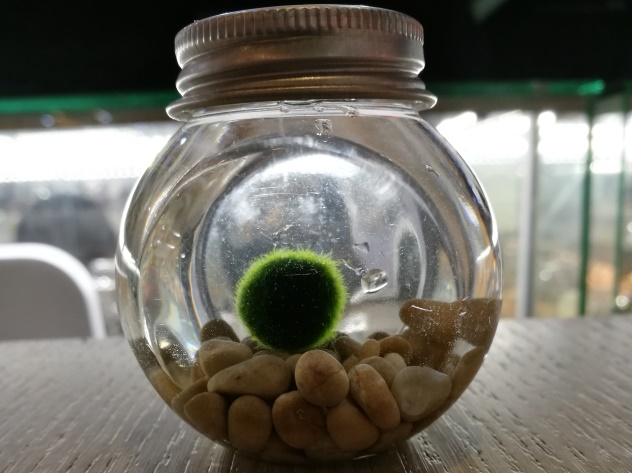There is a new fad in town and its name is Marimo moss balls, also known as Cladophora ball, Lake ball, Mossimo or Moss Balls. I was at Candy Box on the first floor of Imperial Mall Old Wing when I saw these moss balls being sold at one of the boxes in the store. Each moss ball is stored in a bottle and is retailed at RM25 or RM35 depending on the size of the bottle. These moss balls are all small size ones as big ones would command a much higher price. My sister-in-law and her niece from Bintulu each bought one of the RM25 type.
Marimo(毬藻), a Japanese word which literally translates to “seaweed ball” are not moss at all – they’re actually a rare form of spherical filamentous green algae with a velvet-like appearance found mostly in lakes in the northern hemisphere. There’s no central stone or kernel inside the sphere – it’s solid algae, radiating from the center, growing radially outward at a snail’s pace of just 5mm per year, eventually reaching 2 to 5 inches in aquariums. But in their natural habitats – few fresh water lakes in Japan, Estonia, Iceland, Scotland and Australia – colonies of such balls have been known to grow to between 8 and 12 inches in diameter! The plant was named “marimo” by a Japanese botanist Takiya Kawakami (川上瀧彌 ) in 1898.
Domesticated marimo balls are very easy to maintain. They can live with all types of fish. No food or fertilizers are needed since they create their own food through photosynthesis. It’s okay to use fertilizer for other plants in the tank, which may promote faster growth.
Indoors they need to be kept in clean, cold water with low lighting. Marimo balls thrive when they’re clean. Every one to two weeks, change the water and gently rinse them to remove any accumulated debris. Gently roll them in your hands and lightly tap with your fingertips to re-shape. I t’s fine to use tap water but for best results, allow water to sit out for 24 hours prior to changing the water . The temperature should stay below 77°F (25°C). The moss balls can be kept in a covered or uncovered container. A cover will help keep the water clean. Place the balls in low indirect sunlight or low artificial light. Avoid direct sunlight, as it will burn and possibly kill them.
Waterlogged marimo moss balls will stay at the bottom of a tank, but otherwise they float to the top or move up and down. It’s important to keep their surface clean and evenly exposed to the light. Healthy marimo balls will be bright green. Variations in colour may indicate the water is too warm or not clean enough, or the light is not optimal. A lighter or white colour could mean they are getting too much light. If the balls turn brown or grey, they likely need to be cleaned. Do this and gently rotate them in the tank so any brown spots are facing the light source. A small amount of salt, up to 5 percent of total water volume, can be added to the tank to encourage growth. Larger balls can be divided or may grow baby balls that later detach, creating a small indoor marimo ball colony. With the right environment and cleaning routine, marimos easily live to 100+ years. For this reason, it is often joked that Marimo make wonderful family heirlooms.

If your Marimo balls have an air bubble trapped inside, they may float. Gently squeeze your marimo balls to pop the air bubble. Generally, Marimo will sink to the bottom of their tank within 1-2 days of being added to an enclosure.
To ensure that Marimo stay keep their round form and don’t flatten out, you’ll want to gently agitate the water in your Marimo enclosure, with the goal that when your Marimo balls settle back to the bottom, they rest on a different side than they had prior. Try to simulate the gentle waves of a lake.
Marimo moss balls can survive without water if kept in plastic or a closed jar for several days as long as they are kept moist and wet. Plastic bags are the easiest way to travel with Marimo moss.
Another reason to love Marimo moss balls is the beautiful lore that surround these mysterious aquatics. Legend tells of two lovers who desired nothing more than to be together. When their love was forbidden, they fell into the water, and their hearts became Marimo balls. Marimo are said to bring your heart’s desire to both giver and receiver. Hmmm, will these moss balls become the rage when the next Valentine’s Day comes around?
 CY@CY Says Welcome to my dreamscape. Where a Lim is also a Ling.
CY@CY Says Welcome to my dreamscape. Where a Lim is also a Ling.
